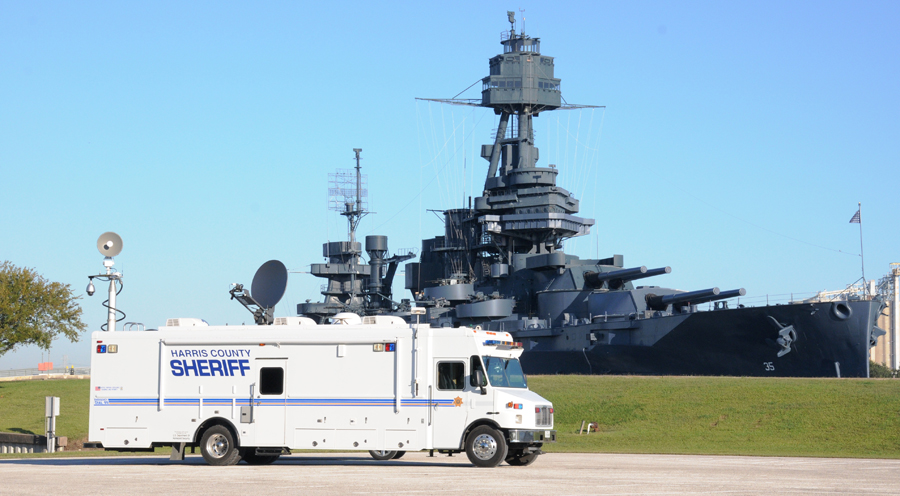FirstNet Public Safety LTE Gains Momentum
Broomfield, CO - Even a year ago, FirstNet still seemed largely theoretical as it went through the planning process. But, with the agency having released its request for proposal in January, and expecting to make an award of its $6.5 billion for the design and construction of the network in early November, the focus of vendors has sharpened considerably even if they don't plan to bid for the overall contract. That new level of interest and expectation, and new energy around the practicalities of a separate wireless broadband network for public safety, was evident at last week's International Wireless Communications Expo in Las Vegas.
Internet of Public Safety Things Project
Wallingford, CT – The IJIS Institute awarded its 2016 Innovation Award to Intel, Mutualink and the San Mateo County Sheriff’s for “The Internet of Public Safety Things: Urban Shield Results”. This exciting area of emerging public safety technology is transforming the ways that first responder teams interoperate to accomplish their missions. “On behalf of Sheriff Munks and our partners at Intel, we are extremely honored to receive the 2016 Innovation Award from the IJIS Institute,” said Mark Hatten, CEO, Mutualink. “We collaborated with the goal of equipping the next generation of first responders with interconnected technology that can ultimately save lives in emergency scenarios. Sheriff Munks and his team demonstrated that the Wearable Smart Gateway, our first entry in the Internet of Public Safety Things category, is indeed a game-changer for the public safety community.”
The rollout and integration of Mutualink into NY Responds will begin in 2016
Wallingford, CT – The IJIS Institute awarded its 2016 Innovation Award to Intel, Mutualink and the San Mateo County Sheriff’s for “The Internet of Public Safety Things: Urban Shield Results”. This exciting area of emerging public safety technology is transforming the ways that first responder teams interoperate to accomplish their missions. “On behalf of Sheriff Munks and our partners at Intel, we are extremely honored to receive the 2016 Innovation Award from the IJIS Institute,” said Mark Hatten, CEO, Mutualink. “We collaborated with the goal of equipping the next generation of first responders with interconnected technology that can ultimately save lives in emergency scenarios. Sheriff Munks and his team demonstrated that the Wearable Smart Gateway, our first entry in the Internet of Public Safety Things category, is indeed a game-changer for the public safety community.”
Mobile Command Post Technologies – improve field communications
Most law enforcement and emergency responders will agree the single most important factor after a catastrophic event is maintaining order, providing aid and restoring stable, effective communications in the field, which becomes a monumental task when traditional power is unavailable. In early 2013, the Harris County Sheriff Office Mobile Command Unit met to analyze the deficiencies of existing equipment and formulated a plan for comprehensive technological updates. Recognizing budgetary limitations, grant funding was sought for these necessary upgrades. The Federal Department of Justice agreed to allow the Sheriff’s Office to use a portion of existing Justice Assistance Grant funding to support the technological updates recommended by the Mobile Command team. Over the next ten months, the Mobile Communications Unit received a massive technology “face-lift” that included some very notable enhancements that brought this Unit into the forefront of public safety mobile communications.
Mutualink, Intel team to provide wearable public-safety gateway with Wi-Fi, Bluetooth connectivity
Mutualink recently unveiled its Wearable Smart Gateway that is designed to let public-safety users securely connect multiple wearable or carried monitors and devices into a lightweight hub powered by Intel’s Edison chip that was developed specifically for Internet of Things (IoT) applications. With the Wearable Smart Gateway, myriad devices—from biometric sensors to body-worn cameras—can be connected via wire, Bluetooth or Wi-Fi with a paired public-safety user at the lightweight device, according to Mike Wengrovitz, Mutualink’s vice president of innovation. Information stored at the gateway can be shared directly in close proximity via the secure Bluetooth or Wi-Fi links to enable on-scene collaboration, he said.
New Technology Gives Police Inside Look at Active Shooter Situations
By: Willard Shepard from NBC Miami http://www.nbcmiami.com/news/local/New-Technology-Gives-Police-Inside-Look-at-Active-Shooter-Situations-330758022.html A move by one South Florida city could save lives if police have to contend with an active shooter. Cutting edge technology is now letting police and emergency responders actually see the danger before they get there. After the horrific tragedy in Oregon, emergency teams across the board are taking a second look at how they would respond. NBC 6 got an inside look at how Miami Beach...
New Jersey FirstNet project takes center stage in Atlantic City
By: Kelly Hill from RCRWireless News The FirstNet early builder project in New Jersey, known as JerseyNet, provided Band 14 coverage at a pair of recent weekend beach concerts in Atlantic City, enabling the police department to sidestep the usual crashing of their mobile security cameras and actually use the system as it was meant to be used. It was the first time the Atlantic City Police Department used the LTE Band 14 network to...
New first responder network passes initial test in Atlantic City
New Jersey’s piece of the nation’s emergency communications broadband network got its first test in August when state and local law enforcement tried it for the first time during two large outdoor concerts in Atlantic City. The inaugural real-world implementation of a wireless broadband network for first responders, known as FirstNet, operated without a hitch. Members of the Atlantic City Police Department and the New Jersey Office of Homeland Security and Preparedness reported they were able to communicate via radio and cellular channels and share video feeds across the JerseyNet interoperable system during Maroon 5 and Rascal Flats concerts that attracted crowds of nearly 50,000 people each.
Mutualink, partners to demonstrate interoperable capabilities, New Jersey LTE solutions during APCO
Interoperable solutions provider Mutualink and three partners—PMC Associates, Oceus Networks and Hughes—next week will demonstrate their collaborative capabilities that are being deployed in the New Jersey public-safety LTE early-builder project. Mutualink will show its interoperability capabilities on the show floor—the partnering companies are using combined space in booths 2236, 2238 and 2137 in the exhibit hall at the APCO show in Washington, D.C.—where a trailer with an LTE system on wheels (SOW) and a tactical node will be displayed, according to Mutualink CTO Joe Boucher. “The system on wheels includes some Mutualink PTT gateway capability, and the tactical node contains additional PTT capability, as well as radio gateways and video gateways,” Boucher said during an interview with IWCE’s Urgent Communications. “Between the system on wheels and the tactical node, these units will be able to offer multimedia collaboration between on-scene agencies, even when there’s no backhaul present to the greater network at large.
Mutualink’s collaboration platform part of New Jersey’s deployable public-safety LTE solution
New Jersey’s deployable public-safety LTE system will include collaboration software from Mutualink that is designed to ensure local-area interoperability via multiple technologies in almost all circumstances, as well as long-range interoperability when backhaul connectivity is available. In cooperation with FirstNet, the state of New Jersey this year is establishing a first-responder LTE system comprised entirely of deployable equipment. Mutualink’s media-cohesion solution—demonstrated last fall in the Urban Shield exercise with system-on-wheels (SOW) partner Oceus Networks—will be deployed throughout the system to provide flexible communications, according to Mike Wengrovitz, Mutualink’s vice president of innovation.
Kenya Mall Terror Attack Reinforces a Disturbing Pattern
The ongoing terrorist siege of a Kenyan Mall offers another clue in the evolving strategy of radical Islamist terrorists. As I have previously written, the Mumbai Hotel attacks represented an evolutionary step in terror thinking. With the hardening and increased security around air transportation, terrorists have changed tactics and moved to other more vulnerable civilian targets. Generally, places of routine mass public gathering are becoming more alluring targets because of the general ease of access,...





